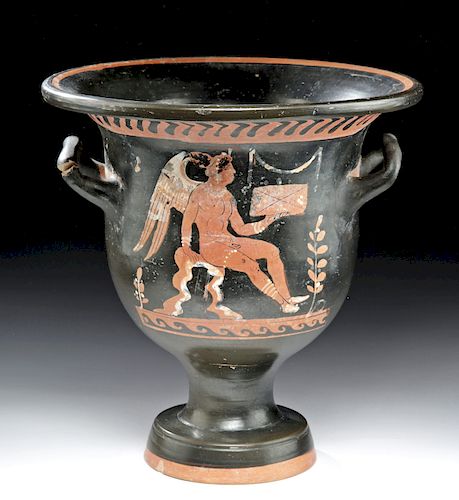Greek Apulian Red Figure Bell Krater w/ Eros
Lot 34
About Seller
Artemis Gallery
686 S Taylor Ave, Ste 106
Louisville, CO 80027
United States
Selling antiquities, ancient and ethnographic art online since 1993, Artemis Gallery specializes in Classical Antiquities (Egyptian, Greek, Roman, Near Eastern), Asian, Pre-Columbian, African / Tribal / Oceanographic art. Our extensive inventory includes pottery, stone, metal, wood, glass and textil...Read more
Estimate:
$5,000 - $8,000
Absentee vs Live bid
Two ways to bid:
- Leave a max absentee bid and the platform will bid on your behalf up to your maximum bid during the live auction.
- Bid live during the auction and your bids will be submitted real-time to the auctioneer.
Bid Increments
| Price | Bid Increment |
|---|---|
| $0 | $25 |
| $300 | $50 |
| $1,000 | $100 |
| $2,000 | $250 |
| $5,000 | $500 |
| $10,000 | $1,000 |
| $20,000 | $2,500 |
| $50,000 | $5,000 |
| $100,000 | $10,000 |
| $200,000 | $20,000 |
About Auction
By Artemis Gallery
Sep 26, 2019
Set Reminder
2019-09-26 10:00:00
2019-09-26 10:00:00
America/New_York
Bidsquare
Bidsquare : Exceptional Day 1: Antiquities & Asian Art
https://www.bidsquare.com/auctions/artemis-gallery/exceptional-day-1-antiquities-asian-art-4437
Day 1 of an important 2-day auction featuring exceptional, museum-worthy examples of Egyptian, Greek, Etruscan, Roman, Viking, Russian, Near Eastern, as well as Asian Art from China, Japan, Thailand, Vietnam, Burma and India. Artemis Gallery info@artemisgallery.com
Day 1 of an important 2-day auction featuring exceptional, museum-worthy examples of Egyptian, Greek, Etruscan, Roman, Viking, Russian, Near Eastern, as well as Asian Art from China, Japan, Thailand, Vietnam, Burma and India. Artemis Gallery info@artemisgallery.com
- Lot Description
Magna Graecia, South Italy, Apulian, ca. mid 4th century BCE. A lovely, sizeable bell krater painted with a rich iconographic program created via the red-figure technique. On Side A is a winged Eros, the Greek god of love (his Roman counterpart being Cupid) seated upon a rocky outcrop and holding a casket in his raised left hand, his right hand placed upon the rocky outcrop. Eros is nude with nicely delineated anatomy; however, he is adorned with bracelets, a beaded band around his right thigh, bands wrapped around his right calf, a beaded necklace and headpiece. In the field is a fillet above the casket and leafy berried plants flanking Eros. Side B features the head of a Lady of Fashion in profile facing left. She is adorned by a beaded drop earring, a beaded saccos, and a double strand around her neck. Just like Eros, she too is flanked by leafy berried plants. Size: 9.875" in diameter at widest x 10.125" H (25.1 cm x 25.7 cm)
In addition to this iconography, the vessel presents an attractive decorative program; a band of abstract chevrons beneath the rim, a band of running wave motifs below Eros, and a lower register underscoring the Lady of Fashion comprised of Greek key (meander). In addition to the skillfully executed red-figure technique, additional details were created via fugitive white pigment.
Perhaps the most exciting innovation in Greek vase painting was the red-figure technique, invented in Athens around 525 BCE and beloved by other artists of Magna Graecia. The red-figure technique allowed for much greater flexibility as opposed to the black-figure technique, for now the artist could use a soft, pliable brush rather than a rigid metal graver to delineate interior details, play with the thickness of the lines, as well as build up or dilute glazes to create chromatic effects. The painter would create figures by outlining them in the natural red of the vase, and then enrich these figural forms with black lines to suggest volume, at times perspectival depth, and movement, bringing those silhouettes and their environs to life. Beyond this, fugitive pigments made it possible for the artist to create additional layers of interest and detail as we see in this example.
Provenance: private J.H. collection, Beaverton, Oregon, USA
All items legal to buy/sell under U.S. Statute covering cultural patrimony Code 2600, CHAPTER 14, and are guaranteed to be as described or your money back.
A Certificate of Authenticity will accompany all winning bids.
We ship worldwide and handle all shipping in-house for your convenience.
#149640Handles repaired with some repainting and small section of loss to one as shown. Minute nicks to the rim and perimeter of the base. Tiny spall to interior of rim. Chip to Lady of Fashion's neck. Normal surface wear commensurate with age with slight pigment losses, but the imagery remains strong. Mineral deposits grace the surface (including underside of base) and the black glaze has developed a marvelous silvery iridescence.Condition
- Shipping Info
-
All shipping is handled in-house for your convenience. Your invoice from Artemis Gallery will include shipping calculation instructions. If in doubt, please inquire BEFORE bidding for estimated shipping costs for individual items.
-
- Buyer's Premium



 EUR
EUR CAD
CAD AUD
AUD GBP
GBP MXN
MXN HKD
HKD CNY
CNY MYR
MYR SEK
SEK SGD
SGD CHF
CHF THB
THB
















